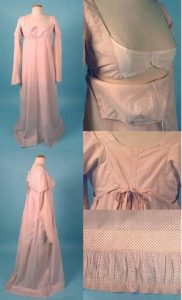
by Donna Hatch
www.donnahatch.comLadies in Regency England had no real money of their own. Before they married, their fathers were in possession of all their money. After they married, all of the money, possessions, and property went to their husbands immediately upon marriage unless it was tied up in some kind of trust which specified the husband couldn't have it. However, ladies had ways of spending money without having to ask, even if their father or husband technically held their purse strings.
When a lady married, she almost always had a marriage settlement or contract similar to today's prenuptial agreement. In the agreement, it outlined her dress and clothing allowance, pin money, and jointure--what she received in money or housing if she outlived her husband. Early in my research into the Regency Era, I found it odd that pin money would be called out in the settlement. Why pin money? Was it actually used for pins, or was it a vague term?
Truthfully, pin money was meant to buy pins. At least, in the beginning. Oddly enough, pins were an indispensable part of a lady's wardrobe. Zippers had not yet been invented, and not every gown had buttons or hooks and eyes. Some gowns needed ties to fasten together. However, a great many ladies relied on pins to keep their clothing together. Yes, straight pins, not safety pins. I assume women either got stuck a lot or knew a trick to avoid such misery. A popular type of gown was an apron style, also known as drop-front or bib-front gowns. These were not only fashionable during the earl Regency, but also comfortable. They could also be easily adjusted if the lady's figure changed due to weight gain or loss, or pregnancy. They were also ideal for hand-me-downs.
Here is a picture of a drop-front gown I found on Isobel Carr's website, and she was gracious enough to give me permission to use it. This a great example of this style of gown--typically a day gown in muslin or calico, although I found an evening gown in velvet with a drop front. As you can see, the gown in this picture needs to be either pinned, buttoned, or hooked with hooks and eyes, and then also tied under the bust in back.
Since pins in those days were not made from stainless steel but rather from brass, they rusted quickly. This made them a consumable product. Expensive, necessary, and consumable, they became a major expense for a lady to undertake. However, pin money was not meant exclusively to buy pins. It actually became a type of allowance a lady had to spend on whatever she wanted. Her annual wardrobe expense was set, and she really had no money of her own, so she used her pin money for incidental expenditures. A lady could use pin money to buy supplies for anything she wanted--her craft supplies, sheet music, entrance into parks or museums or subscription balls, perfume, or treats at Gunther's Tea shop, to name a few.
In some Regency romance novels, the heroine uses her pin money to pay for postage to send secret letters or even to buy stage coach fare (and food) to run away from home. The possibilities are endless if she has a generous pin money or is wise enough to save her pin money for important things.







1 comment:
I doubt ladies really got 'stuck' all that often by the pins holding their clothing together. In the 18th century, they wore stiff stays, which protected their bodies from pins migrating inward. And even in the early 19th century, when stays were softer and less rigid, I know from my own Regency costuming that the stays layer is still firm enough to protect the body. To prevent a straight pin from catching on your arms or other bits of clothing, you bury its point between the layers you're wearing. So, if you're using a pin to close the bib of an apron/drop-front gown, you slip the pin into the layers to hold them together and then instead of leaving the point exposed, you slip it into the layers again. I've used this technique many times, and have never been stuck through the dress and stays, or had the point catch on anything else.
Post a Comment